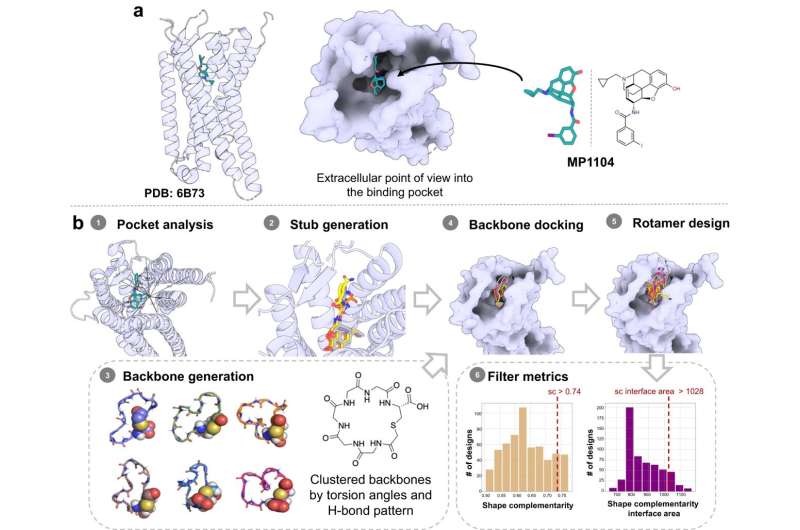This article has been reviewed according to Science X's editorial process and policies. Editors have highlighted the following attributes while ensuring the content's credibility:
fact-checked
peer-reviewed publication
trusted source
proofread
New approach to drug discovery: Developing pain medication with fewer side effects

People with chronic pain are often dependent on drugs from the class of opioids with sometimes considerable side effects. Accordingly, in recent years the search for safer alternatives has been the focus of new drug discovery.
As part of an international study led by MedUni Vienna, an opioid-like molecule has now been developed which, as shown in animal models, can effectively alleviate pain but with fewer undesirable side effects. The researchers developed a computer-assisted workflow that holds enormous potential for improving the search for drug-like substances and thus drug therapies. The study was recently published in Nature Communications.
Opioid prescription drugs that are frequently used in pain medication can lead to drug dependence with serious consequences, including respiratory depression, which is potentially lethal, in particular when the opioid is overdosed or used in combination with sedatives (such as alcohol or sleep medication). The international research team led by Christian Gruber with first author Edin Muratspahić from the Institute of Pharmacology at MedUni Vienna focused on developing new possibilities to find alternative pain remedies.
Opioid analgesics such as fentanyl or morphine mainly act on the so-called µ-opioid receptor in the brain, which is associated with the serious side effects. Therefore, the researchers from Austria, Australia and the U.S. set out to find drug candidates that bind to a related receptor, the so-called κ-opioid receptor, another important receptor for pain regulation in the human body.
New pathways for drug development
To specifically design chemical compounds that have a high affinity for their drug target, the researchers used a novel computer-aided design method. The "de novo" design approach has now been used to generate compounds that target the family of G protein-coupled receptors (abbrev. GPCR), which constitutes one of the most important pharmacological drug targets for approved therapeutics.
Using a combination of "de novo" design, pharmacological as well as structural analyses, only four compounds had to be synthesized and experimentally validated to finally identify a promising drug-like molecule: DNCP-β-NalA(1) ("De novo circular peptide-β-naloxamine").
As the study exemplified, this newly developed opioid-like compound had a strong pain-relieving effect in animal models without triggering associated unwanted symptoms such as sedation or dysphoria. Through targeted activation of individual cellular signaling pathways of the κ-opioid receptor, this drug candidate thus promises better tolerability with a simultaneous reduction of side effects.
"Within the course of our study, we have developed a workflow that facilitates the discovery and development of novel painkillers," says study leader Christian Gruber, highlighting the scope of the research work.
The "de novo" design process offers an enormous improvement over existing drug discovery methods commonly used in pharmaceutical research, such as structure-based virtual library or molecule-based high-throughput screenings. Since the κ-opioid receptor is a prototypical GPCR, the method may be applied, in the future, for the development of better drugs with reduced side effects for other GPCRs that are important in the treatment of, for example, cardiovascular, metabolic or mental diseases.
The potential of the currently discovered molecules as pain therapeutic will have to be investigated and confirmed in further studies. "Even if successful, it may be several years before these may be approved for clinical use. Still our discovery should provide hope to many patients suffering from chronic pain," says Gruber.
More information: Edin Muratspahić et al, Design and structural validation of peptide–drug conjugate ligands of the kappa-opioid receptor, Nature Communications (2023). DOI: 10.1038/s41467-023-43718-w
Journal information: Nature Communications
Provided by Medical University of Vienna




















